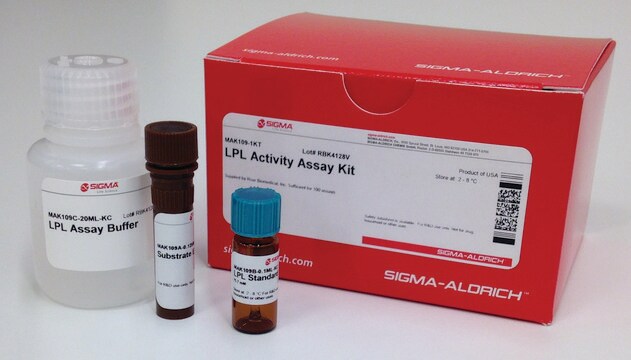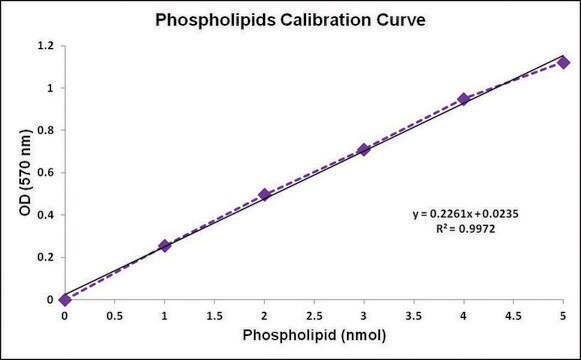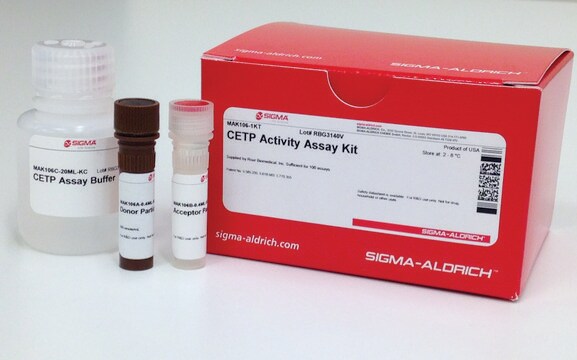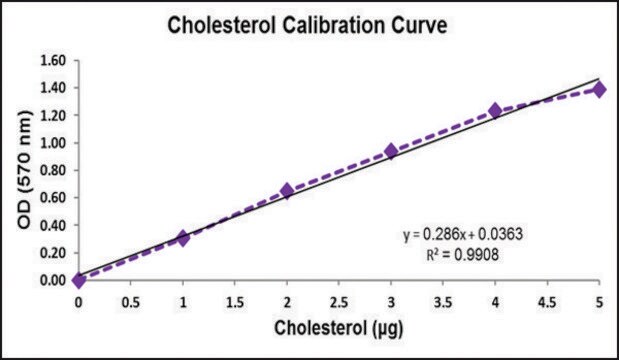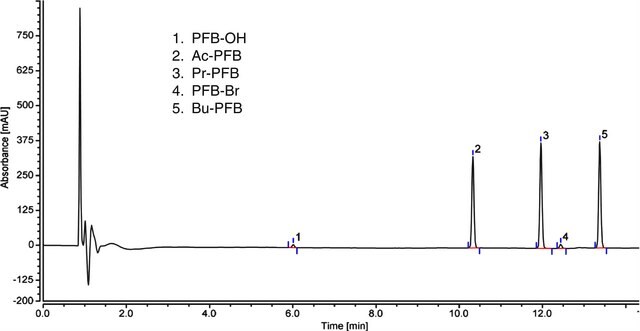MAK108
PLTP Activity Assay Kit
Supplied by Roar Biomedical, Inc.
Synonym(s):
Phospholipid transfer protein activity assay kit
Sign Into View Organizational & Contract Pricing
All Photos(2)
About This Item
UNSPSC Code:
12161503
NACRES:
NA.84
Recommended Products
usage
sufficient for 100 fluorometric tests
application(s)
pharmaceutical
detection method
fluorometric
relevant disease(s)
cardiovascular diseases
storage temp.
2-8°C
Gene Information
human ... PLTP(5360)
Related Categories
General description
Phospholipid transfer protein (PLTP) is a protein present in normal human plasma. PLTP transfers phospholipids among lipoproteins in plasma.
Suitability
Suitable to determine Phospholipid transfer protein (PLTP) activity in plasma or serum (fresh or frozen) as well as other sources of PLTP.
Principle
The PLTP Activity Assay Kit includes proprietary substrates to detect PLTP mediated transfer of fluorescent substrate. Transfer activity results in increased fluorescent emission intensity (λEx = 465 nm/λEm = 535 nm) from the assay.
Storage Class
10 - Combustible liquids
Certificates of Analysis (COA)
Search for Certificates of Analysis (COA) by entering the products Lot/Batch Number. Lot and Batch Numbers can be found on a product’s label following the words ‘Lot’ or ‘Batch’.
Already Own This Product?
Find documentation for the products that you have recently purchased in the Document Library.
Natacha Bellanger et al.
Arteriosclerosis, thrombosis, and vascular biology, 31(7), 1675-1681 (2011-04-30)
Low high-density lipoprotein (HDL) cholesterol levels are frequently observed in familial hypercholesterolemia (FH) and might be associated with functional alterations of HDL particles that may influence their efficaciousness in the reverse cholesterol transport pathway. We evaluated key steps of the
Alexina Orsoni et al.
Journal of lipid research, 53(4), 767-775 (2012-02-18)
In familial hypercholesterolemia (FH), low HDL cholesterol (HDL-C) levels are associated with functional alterations of HDL particles that reduce their capacity to mediate the reverse cholesterol transport (RCT) pathway. The objective of this study was to evaluate the consequences of
Ryan J Henderson et al.
Drug development and industrial pharmacy, 35(9), 1139-1146 (2009-04-22)
To investigate how different formulations of Amphotericin-B (Amp-B) affect the activity of phospholipid transfer protein (PLTP) when incubated with hyperlipidemic and normolipidemic plasma at physiological temperature (37 degrees C). Six hyperlipidemic and six normolipidemic plasma samples were collected and tested
Sander J Robins et al.
Atherosclerosis, 228(1), 230-236 (2013-03-13)
Cholesteryl ester transfer protein (CETP) and phospholipid transfer protein (PLTP) are two genetically-related plasma proteins involved in the exchange of cholesteryl esters and phospholipids between high-density lipoproteins (HDL) and other lipoproteins. Although low CETP and high PLTP activity both result
Marta Marchesi et al.
British journal of pharmacology, 164(5), 1460-1468 (2011-04-14)
Besides a significant reduction of low-density lipoprotein (LDL) cholesterol, statins moderately increase high-density lipoprotein (HDL) levels. In vitro studies have indicated that this effect may be the result of an increased expression of apolipoprotein (apo)A-I, the main protein component of
Our team of scientists has experience in all areas of research including Life Science, Material Science, Chemical Synthesis, Chromatography, Analytical and many others.
Contact Technical Service